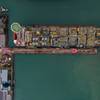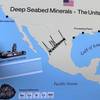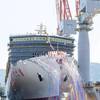Feature: Ship Enters Harbor, Returns Without Incident
By Don Sutherland
How many great ships have graced the front page of The New York Times? In a century and a half of publication, the newspaper of record has featured plenty. Ships were once the technological measure of civilization, like the automobiles and aircraft and TVs and PCs and Gameboys that followed. All of them characterized and defined an epoch, an age, a generation. Each changed the things people did, the way they saw, how they thought, spoke, and behaved.
Yet of all those technological inspirations, the most truly regal, the most romantic were ships. They are the most embracing. People dine and sleep aboard. Some earn their livings and some play. All go to the bathroom, many recreate, perhaps even procreate on ships. People are sometimes born on ships. Ships are the thin-skinned ode to life on the otherwise deadly sea, the bodies that nestle and nurture and keep us safe. They're maternal that way, or at least strike us so, which is why we persist in calling them "she."
And, by extension, they're a little foreboding. Two thousand souls may be gathered, with a comparative eggshell between them and eternity. Sometimes it's breached. And when that happens, it's a stupendous betrayal of aspiration and faith and expectation. It gets printed in big type under banners on page one.
How many great ships? None can be forgotten, of course, but four stand out as widely discussed, among passenger ships at least. Each met with adversity that was not just formidable, but poignant and ironic as well. There was the Titanic. Unsinkable, yet sank the first time out. Not only The Times, but uncountable novels, plays and musicals, films have kept her triumphs and agonies current. There are people today who've never heard of the Exxon Valdez, but know all about the Titanic.
There was the Lusitania. Packed with innocents, picked-off by a U-boat, she's one of the reasons we entered the World War. Decades later, intimations would arise that the ship was carrying munitions after all. But that didn't reach The Times back in 1915.
There was the Andrea Doria, whose unwitting adversary, the Stockholm, left landlubbers incredulous - with thousands of miles of ocean all around, how could mere specks collide? Each of these disasters became more than just shipwrecks. They symbolized other principles, addressed ideologies and debates raging elsewhere.
But those were twentieth-century debates. We entered that century as an industrial nation, exited it service-based. You knew pretty soon if a steamship was any good. But services are harder, or at least take longer, to qualify. Absent a track record, you've got to have an image. Belief-systems, the most elaborately embroidered architectures of the age, are built and delivered like hulls used to be on the banks of the East River. So, which ship makes the big splash, and for what, in Century 21?
Dawn of a New Era
"G.O.P. Option at Convention: Luxury Liner," announced the Times headline on the same front page that had announced the loss of the Titanic. But from there, rather than grief and sorrow per the Lusitania, the vaguely Democrat Times gleefully gloated.
"Mr. [Tom] DeLay, of Texas, has proposed chartering [a] 2,240-passenger luxury cruise liner for the [Republican National] convention, docking it in the Hudson River, so that Republican members of Congress and their guests can all stay at one place."
The ship was the Norwegian Dawn, which by coincidence we had photographed not long before, as it made an unexpected maneuver in the Narrows. Naturally we were interested in this front-page discussion, to see if it shed any light on the ship's unconventional behavior.
"New York would lose money if Mr. DeLay decides to charter the ship," The Times continued, "because it would draw visitors - and dollars - away from city hotels, restaurants and shops." And those business interests have great expectations for Republican wallets. "Labor leaders said yesterday that to help bring the convention to New York, they had agreed to guarantee they would not strike during the convention," The Times reported. Concerned labor leaders included Peter Ward, president of the New York Hotel Trades Council, representing hotel workers.
"'Everything that every union leader did, every civic leader did, every government leader did to bring the convention here was done for one reason: to bring business into the city to stimulate jobs and raise the tax base,' Mr. Ward said. 'And for these guys to rent a boat to stay out in the river, and not pay hotel occupancy tax, is just an outrage.'" It's a high-minded union leader that The Times gives us, so protective as this toward the tax base.
But Mr. Ward placed the Norwegian Dawn "out in the river." And it is true in certain parts of Manhattan island that the Hudson seems further away than Toledo. A Times editorial on December 2 extends the abyss even further. "New York's landlubbers find it more ludicrous than insulting," the editorial opens, "that Tom DeLay, the majority leader of the House of Representatives, may offer to house hundreds of solons, fat-cat donors and lobbyists in a luxury cruise ship off the Manhattan shore."
Off the Manhattan shore? Well yes, technically speaking, the ship is, for the sake of discussion, a hundred feet beyond the bulkhead. But when they say "offshore," don't most people mean out in the ocean, as in "offshore drilling platforms?"
The Norwegian Dawn more accurately is quasi on shore, de facto on shore, ad hoc on shore, as far as reaching it is concerned.
Ships like the Norwegian Dawn are now connected to land by piers. Been awhile since passengers were rowed-in from ships in dories, by boatswains under the coxswain's call of, "har, me hearties!" The most recent recreational piers may not have tie-ups, but there are still a few older piers, ship piers, that do. Give or take a few incidentals, ships at these docks are as accessible by taxi as any hotel in town.
The 900-Pound Ephemera
"As for the more ephemeral issue of perception," The Times continues, "the proposal to remove visitors from the hubbub of city life has been broadly received as a slight - a suggestion that the city's hotels and restaurants, not to mention its people, are not quite good enough for Republicans from out of state."
Cruise ships remove visitors from the hubbub of city life? That's news to us. We always thought they brought passengers into said hubbub. You could say the ship helps make the hubbub, is even central to it, in New York City of all places. Both the Titanic and the Andrea Doria were New York-bound, and the Lusitania had just left. A lot of hubbub passes through the city, to and from the harbor
"Mr. DeLay's aides, as well as representatives for the cruise line," The Times recounted in its December report, "have tried to argue that Norwegian Cruise Line brings business to the city because the ship operates out of New York year round, and that this, too, would bring in revenue. Local people would be hired for jobs like baggage handling and passenger check-in."
So that's why the Republicans had gone after the charter? Out of their concern for unemployed baggage-handlers and check-in clerks? Actually, the Republicans hadn't gone after the charter.
"The idea of using the cruise ship," The Times recounts, "first came up when the company approached Republican leaders several weeks ago, a company spokeswoman said. The cruise line has also approached Democrats about their convention."
(One week later, The Times would list the owners of the Norwegian Dawn as "Norwegian Cruise Line, a subsidiary of Star Cruises, which has its headquarters in Hong Kong and is run out of its offices in Malaysia; Star Cruises is in turn a unit of Genting Berhad, a holding company in Kuala Lumpur, Malaysia," whose American headquarters are in Miami. The Times would also describe them as "growing {in} sophistication in the ways of Washington.")
So when a cruise line pitches a cruise ship with "15 decks, 14 bars and lounges, 10 restaurants and babbling brooks," "shows, fine works of art, health clubs, bars, cafes, amazing views, luxury staterooms and restaurants serving cuisine from around the world," and "a children's park with a dinosaur theme" (all The Times' language), it's pitching not just a cruise ship. It's pitching a venue for all occasions. Like the stadiums and arenas and convention centers so many municipalities so vigorously pursue. Though, somehow, this one is different.
"Having some of the G.O.P.'s best and richest walk a gangplank to and from the city each day has just the hint of xenophobia that already finds Democrats dancing in the streets," declared a Times editorial on December 2, taking exception to Mr. DeLay's comment about "good security" aboard the ship. "What is the normally bold Texan afraid of? The ghosts of squeegee beggars? Pedestrian Democrats?"
Other politicians waxed similarly. "'What is it? They don't want to be contaminated by us?'"said Representative Charles B. Rangel, a Democrat from Harlem," The Times reported the next day. And of course, Mr. Rangel's "us" is a much more sensitive "us" than even easily-offended Manhattan liberals.
Elephants and Donkeys all High on the Hog
The Times tells us elsewhere that Mr. DeLay has, indeed, made points by treating colleagues to premium perks. "At the Republican convention in Philadelphia in 2000, he provided representatives with cars and drivers, and he set up a hospitality suite inside a luxury railroad car." Mr. DeLay seems to be quite the transportation buff. Indeed, at that same convention he also provided a ship, so what could seem more natural this time around? It was no cruise ship then, however, and none of the conventioneers lived aboard. The USS New Jersey (BB 62) served simply as a prop. We can only speculate on that backdrop's influence upon the course of the nominations.
But this time Mr. DeLay gave up the ship, for even Republicans - as quoted in The Times - were apprehensive about the image the Norwegian Dawn conveyed. "'In an era of nonstop news and visuals, do you want the visual of the convention to be a group of people sequestered on a cruise ship?" said one Republican strategist, according to The Times. So there you have the ship as frontpage news, in the service economy of the 21st century. Where the frontpage ships of the past made their headlines after sinking, the 21st-century ship makes headlines pre-emptively. The stories and editorials were about not an event, but a proposal. A proposal that would lodge a maximum of 2200 Republicans out of 50,000 expected to arrive, along with another 15,000 members of the media.
The era of nonstop visuals? That's one journalist coming to town for every 3.3 conventioneers. Of course they'd cover more than just the delegates, since New York is so wondrous for background stories. Indeed, if the Republicans had booked the ship, the cameras could linger admiringly over the Intrepid museum almost nextdoor to Norwegian Dawn, or the bustle and glitter ("hubbub," you might say) of the Chelsea Piers, or the allure of the dinner cruises. We wouldn't be surprised if quite a few Republicans found their way over anyhow, even if they're staying at the Hilton.
How many hotel rooms would Norwegian Dawn have siphoned-off? The figure has been 2,200 people, but that assumes double-occupancy. The Norwegian Dawn has 1,112 passenger cabins.
How does that compare to an inland hotel? Well, the Hilton, for example, has 1980 rooms, or 868 more than the ship. That's out of "nearly 17,000 hotel rooms within one mile of Madison Square Garden," according to NYC and Company, the city website, "and signed agreements that secure more than 22,000 hotel rooms for the Convention from nearly fifty hotels." That's twenty times the number of rooms in the cruise ship.
Those 22,000 rooms in those assorted hotels, at double-occupancy, support 44,000 of 65,000 expected delegates and media. That is, another 10,500 rooms are required, and that's just for visitors the Republicans admit to. As one writer put it in a letter to The Times, "Tom DeLay's idea of using a luxury cruise ship ...has a residual benefit: more hotel rooms will be available for anti-Bush demonstrators."
How many ships have graced the front page of The Times? In the 20th century, they had to do something spectacular. In the 21st, they don't have to do anything at all. Just come up in discussion. We don't know if that influenced the Norwegian Dawn on the day we took its picture. But coming up the Narrows, pausing off Tompkinsville, coming about, and heading back where she came from is an exercise we've not before seen. We can only speculate. But at sea, the workplace of ships, people go cruising for one main reason. They can act giddy and goofy, without excuses.










